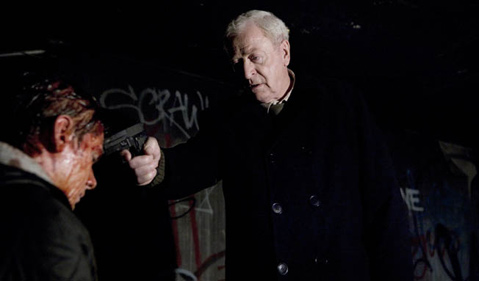Harry Brown
Michael Caine, Emily Mortimer, and Charlie Creed-Miles star in a film written by Gary Young and directed by Daniel Barber.

It is unfortunate, in a way, that Charles Bronson so stubbornly lords over the modern urban one-man vigilante justice genre. Despite his non-acting and the general B-movie grade of his Death Wish series, Bronson, bless his heart and status as a kitsch icon, has become synonymous with the gun-toting, “mad as hell and not going to take it anymore” film category, and other fresh contenders are inevitably compared.
But there’s a new kid, archetype-wise, in town, and he’s far from a kid. Thanks to Clint Eastwood in Gran Torino and now Michael Caine in the mostly fascinating Harry Brown, we have quiet-but-deadly elderly score settlers, eager to clean up the neighborhood and avenge victims at the tail end of their roads. Like Eastwood, Caine plays a pensioner and widower, caught up in the amoral jungle of young thugs and drug-runners, making life deadly in the projects-like compound of “the Estate,” in the mean streets of South London.
A former soldier who goes about his ostensibly quiet life, Caine plays—with a striking, assured, and measured power—a solid citizen whose ire is awakened by the anarchy about him, especially once his friend meets the wrong end of a gang’s blade. In a key, cathartic scene, Caine descends into a demimonde to buy guns, and we immediately smell a metaphor when he says he wants them “to shoot the pigeons off my roof,” as he tells the morally base drug, gun, and general vice dealer, soon to be “Bronson’d.” Later, a policewoman (Emily Mortimer), trying to maintain some semblance of order amid the growing chaos, reminds the elderly vigilante that he’s not in Northern Ireland anymore. “No, there they fought for a cause … for these people, it’s entertainment.”
Although the film ultimately leaves the arthouse and descends into gratuitous orgiastic violence, what elevates Harry Brown above Bronsonian cinematic camp is the steady artistry of the film. Rather than rubbing our face in the violent grit of gangster doings, or dwelling only on that, we are guided slowly, first with a sound design showing our protagonist’s detachment, à la Rear Window. Cinematographer Martin Ruhe also does a masterful job of presenting stately still-life compositions early on and increasing the visceral stakes to convey the quiet life of a man about to find his inner score-settler, with extreme prejudice.



